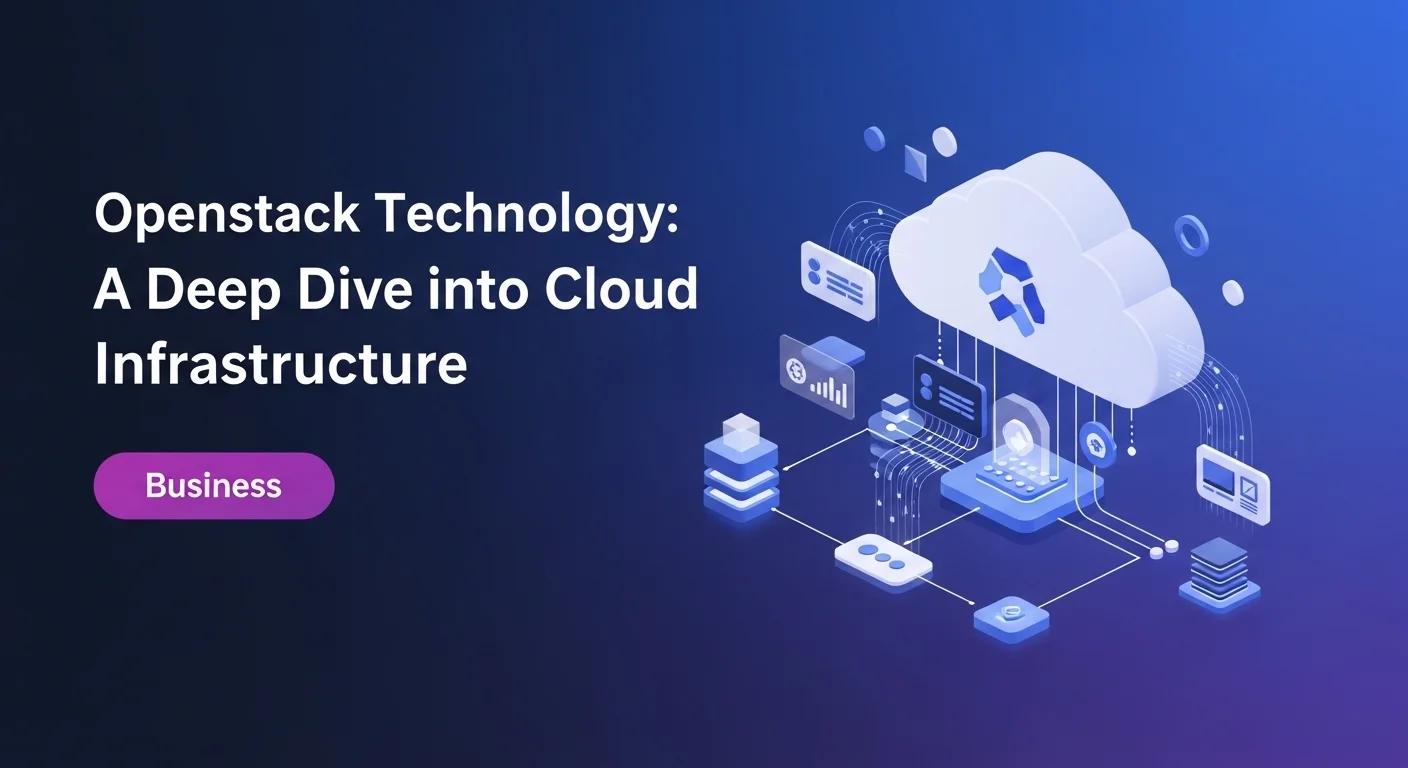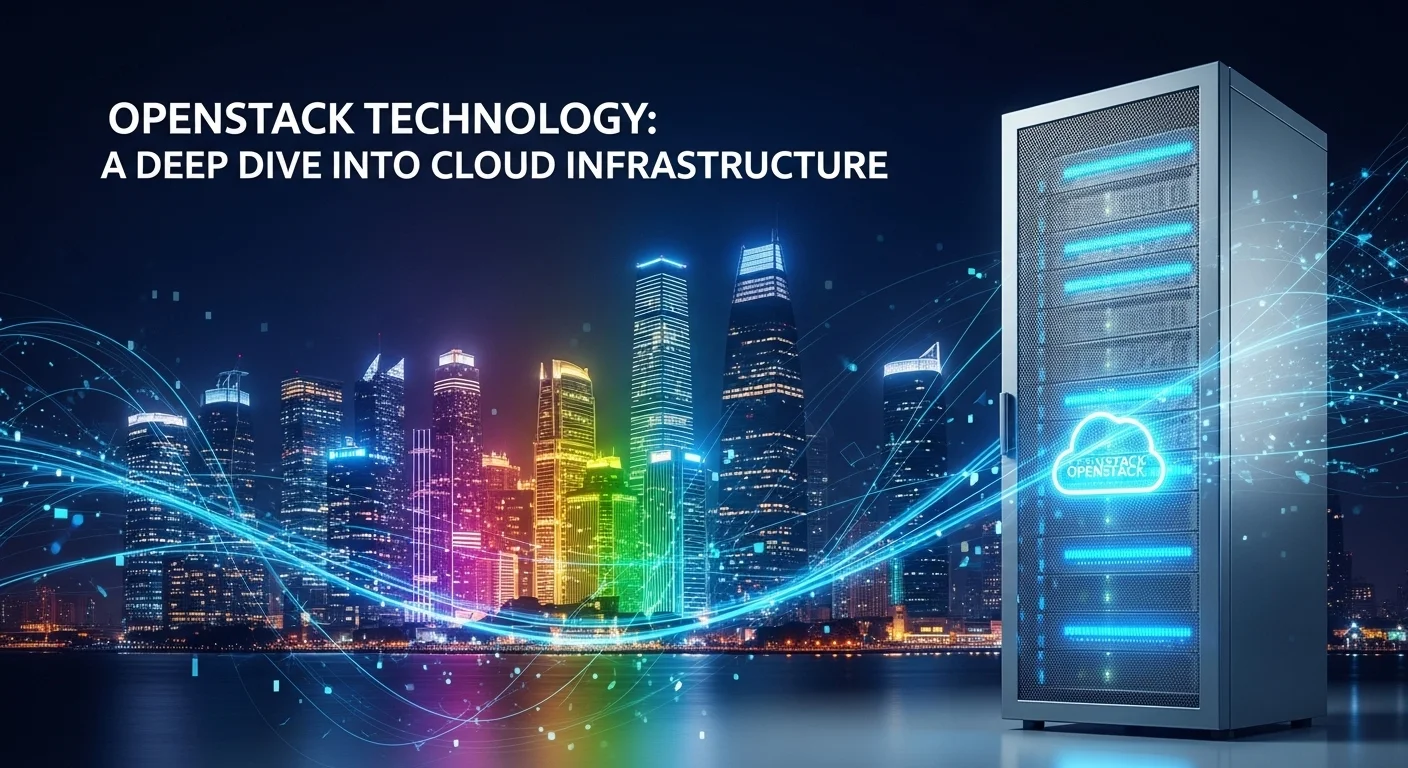What is OpenStack? A Practical Guide to Cloud Freedom

Executive Summary
In my years as a cloud architect, I've seen many businesses feel trapped by the big cloud providers. They come to me looking for flexibility, control, and a way to manage costs without sacrificing power. My answer, more often than not, is OpenStack. It's not just another piece of software; it's a completely different way to think about cloud infrastructure. It's an open-source platform that lets you build your very own private or public cloud using standard hardware. Think of it as being handed the blueprints and tools to construct your own cloud services, tailored exactly to your needs. This article is my deep dive into OpenStack, born from hands-on experience. We'll walk through its core pieces, like Nova for computing power and Swift for storage, and I'll explain why it’s become such a vital tool for anyone serious about their IT strategy. Whether you're a developer, an IT pro, or a business leader, understanding OpenStack means understanding how to achieve true cloud independence.
Table of Contents
Table of Contents
- What is OpenStack and Why Does It Really Matter?
- The Core Architecture: Building Your Cloud with LEGOs
- Real-World Business Applications and Benefits
What is OpenStack and Why Does It Really Matter?
In the world of tech, 'the cloud' can feel like this big, abstract thing. But behind the curtain, it's all about powerful, flexible software managing massive amounts of hardware. One of the most important players in this space, and one I've come to rely on, is OpenStack. So, what is it, in simple terms?
OpenStack is a free, open-source software platform for building and managing clouds. It’s mainly used as an Infrastructure-as-a-Service (IaaS), which is a fancy way of saying it gives you the fundamental building blocks of computing: processing power, storage, and networking. The magic of OpenStack is that it lets you build your own Amazon Web Services (AWS) or Google Cloud, but inside your own data center, on hardware you choose. It gives you a dashboard and a set of tools to control huge pools of resources, offering a level of control that's hard to find anywhere else. It started back in 2010 as a joint project between NASA and Rackspace, which tells you a lot about its DNA—built for massive scale and enterprise-level stability.
Its real importance, from my perspective, comes from its open-source nature. This isn't a product owned by one company. It's built by a global community. That means no vendor lock-in. I’ve seen companies spend fortunes trying to migrate away from a proprietary cloud service. With OpenStack, you're free. You're not tied to one company's pricing, roadmap, or whims. This freedom sparks innovation and keeps costs down, making powerful cloud technology accessible to everyone, from nimble startups to global corporations.
The Core Architecture: Building Your Cloud with LEGOs
I often compare OpenStack to a set of LEGO bricks. It’s not one giant application; it's a collection of individual projects (components) that you can assemble to create a cloud that fits your exact needs. This modularity is its superpower. Let's look at the most important bricks in the box.
- Compute (Nova): This is the engine of your cloud. When a user asks for a virtual server, Nova is the project that brings it to life. I remember my first time deploying it; seeing Nova efficiently schedule and manage hundreds of virtual machines across a rack of servers was a real 'aha!' moment. It’s incredibly flexible and works with different virtualization technologies like KVM or VMware.
- Networking (Neutron): A cloud without networking is just a bunch of isolated computers. Neutron lets you build complex virtual networks. You can create your own private networks, routers, and firewalls with it. This is absolutely critical for keeping different customers' or departments' workloads separate and secure.
- Storage (Swift and Cinder): OpenStack gives you two main ways to store data. Swift is for object storage—perfect for unstructured data like photos, videos, or backups. It's built for huge scale and redundancy. Cinder provides block storage, which acts like a virtual hard drive you can attach to your servers. It's essential for things like databases that need reliable, high-speed disk access.
- Identity (Keystone): In a cloud with many users, you need a bouncer at the door. Keystone is that bouncer. It handles all authentication and permissions, making sure only the right people can access the right resources. It's the central hub for security.
- Image (Glance): Glance is your library of server templates. It stores and manages the virtual machine disk images you use to launch new servers. Think of it as the master blueprint for every server you create.
- Dashboard (Horizon): While pros love using command-line tools and APIs, sometimes you just need a good old-fashioned web interface. Horizon provides a user-friendly dashboard to manage your cloud, from launching servers to configuring networks.
These core services are the foundation of any OpenStack cloud, giving you everything you need for a robust IaaS platform. You can start small and add more components as you grow, which makes it an incredibly adaptable solution.
Real-World Business Applications and Benefits
The technical elegance of OpenStack translates into real-world wins for businesses. I've helped companies in finance, e-commerce, and research use it to transform their operations.
A huge driver is cost savings. By using open-source software on commodity hardware, you can build a private cloud for a fraction of what proprietary solutions or long-term public cloud contracts would cost. This is especially true for predictable, always-on workloads where the public cloud's pay-as-you-go model can get surprisingly expensive.
Flexibility and control are just as important. With your own OpenStack cloud, you call the shots. You can customize it to meet strict security or compliance rules, which is non-negotiable for industries like healthcare or finance. You control where your data lives and how it's protected—a level of control you often give up with public providers.
It's also a catalyst for speed and innovation. It empowers development teams to get the resources they need instantly, through self-service. This DevOps-friendly approach drastically cuts down the time it takes to develop, test, and launch new products. The powerful APIs make automation a breeze, allowing you to build a truly modern, efficient IT operation. Companies like AT&T, Walmart, and CERN have bet big on OpenStack, proving it's a mature platform ready for the most demanding jobs in the world.

A Complete Guide to OpenStack for Technology and Business
Going beyond the basics, OpenStack reveals itself as a deeply sophisticated platform. I’ve seen it evolve over the years from a collection of core services to a rich ecosystem that can tackle almost any business challenge. Let's explore how to deploy it and how it stacks up against the giants of the cloud world.
Choosing Your Path: Deployment Models and Advanced Tools
How you deploy OpenStack is the first major decision you'll make, and it shapes everything that follows. There's no single 'best' way; it's about what’s right for your goals.
- Private Cloud: This is the classic OpenStack use case. You build it on your own hardware, in your own data center. This gives you maximum control, security, and customization. I've worked with many clients who chose this path because they had strict data residency laws or needed to fine-tune performance for specific applications. For stable, long-term workloads, it almost always offers a better total cost of ownership.
- Public Cloud: You might be surprised to learn that many public cloud providers actually use OpenStack under the hood. They offer the power of OpenStack to the public on a pay-as-you-go basis. This is a great way to get started without the upfront hardware investment.
- Hybrid Cloud: This is where OpenStack truly shines, in my opinion. Its open nature makes it perfect for a hybrid strategy. You can run your core, predictable applications on your private OpenStack cloud for cost-efficiency, and then 'burst' into a public cloud to handle sudden traffic spikes. It’s the best of both worlds: control and cost-effectiveness combined with limitless scale.
The OpenStack ecosystem also offers advanced tools for specific jobs:
- Heat: This is OpenStack's orchestration engine. Heat lets you define your entire application infrastructure—servers, networks, storage—in a text file (a template). This is 'infrastructure as code' in action and is fundamental to any serious DevOps practice on OpenStack.
- Ironic: Sometimes, you need the raw power of a physical server with no virtualization layer in between. Ironic is the project that lets OpenStack manage bare metal servers just like virtual machines. It's essential for high-performance computing (HPC) or large database workloads.
- Magnum: With containers taking over the world, Magnum makes it easy to run orchestration tools like Kubernetes directly on OpenStack. It simplifies deploying and managing containerized applications at scale.
- Trove: This project provides a database-as-a-service (DBaaS). It automates the painful parts of managing databases, like provisioning, backups, and patching, letting your teams focus on development instead of administration.
The existence of these advanced components shows just how mature OpenStack has become. It's not just for making virtual machines anymore; it's a comprehensive platform for delivering modern applications.
Business Solutions and Industry Use Cases
The flexibility of OpenStack means it's used everywhere, solving unique problems for different industries.
- Telecommunications & NFV: Telcos are massive OpenStack users. They use it for Network Functions Virtualization (NFV), which means turning network hardware like routers and firewalls into software running on standard servers. OpenStack's powerful networking and compute capabilities are a perfect fit, helping them build next-generation networks that are more agile and cost-effective.
- Big Data and Analytics: When you're dealing with huge datasets, you need a platform that can scale. I've helped teams build analytics platforms on OpenStack to run Hadoop and Spark clusters, allowing them to spin up resources on demand for complex data processing jobs.
- E-commerce and Web Hosting: Major retailers like Walmart use OpenStack to power their online stores. Its ability to scale lets them handle massive traffic spikes during events like Black Friday, all while controlling costs and performance on their private infrastructure.
- Scientific Research & HPC: Institutions like CERN, which generates unimaginable amounts of data, rely on OpenStack to manage their vast computing grids. The ability to provision both virtual and bare metal servers is critical for their world-leading research.
OpenStack vs. the Public Cloud Giants (AWS, Azure, GCP)
It's the question I get asked all the time: 'How does OpenStack compare to AWS?' The truth is, they serve different purposes. It’s not about which is 'better,' but which is the right tool for your specific job.
AWS, Azure, and GCP are polished, productized services. OpenStack is an open-source project—a set of tools you use to build a cloud. This core difference leads to several trade-offs:
- Control vs. Convenience: OpenStack gives you total control. You can tweak everything, choose your hardware, and design it to your exact needs. Public clouds offer convenience—a managed service where many decisions are made for you.
- Cost Model: Public clouds are an operating expense (OpEx), which is great for variability. A private OpenStack cloud is usually a capital expense (CapEx) for hardware, but for steady workloads, it can be significantly cheaper in the long run.
- Freedom vs. Ecosystem: The biggest fear with public clouds is vendor lock-in. OpenStack is built on open standards to prevent that. The flip side is that the hyperscalers offer a vast, mature ecosystem of managed services that are often easier to consume than their OpenStack equivalents.
In the end, many of the smartest organizations I work with don't choose one over the other. They use both. They build a private cloud with OpenStack for their core infrastructure and leverage the unique services of public clouds when it makes sense. That's the power of a true hybrid, multi-cloud strategy.

Tips and Strategies to Master Your OpenStack Cloud
From my time in the trenches with OpenStack, I can tell you that a successful deployment is about more than just technology. It’s about strategy, discipline, and community. Here are some hard-won lessons to help you build and run a stable, secure, and efficient cloud environment.
Best Practices for Deployment and Operations
Getting the foundation right will save you countless headaches later on. Don't rush this part.
- Plan Like a Pro: Before you install anything, have a clear plan. What are you going to use this cloud for? How much capacity will you need? What will your network look like? And please, design for high availability from day one. I've seen too many clouds built with single points of failure that came back to haunt their creators.
- My Golden Rule: Automate Everything: If you have to do a task more than twice, automate it. The complexity of OpenStack will punish you for manual work. Use tools like Ansible or Puppet to deploy and configure your cloud consistently. Inside the cloud, use OpenStack's own Heat orchestration to manage your applications as code. It's the only way to scale sanely.
- Choose Your Deployment Tool Wisely: There are several great tools like Kolla-Ansible and OpenStack-Ansible to help you install the platform. Do your homework. A container-based deployment, for instance, can make future upgrades much, much easier. Pick the tool that best matches your team's skills.
- If You Can't See It, You Can't Fix It: Implement comprehensive monitoring from the very beginning. Use tools like Prometheus and Grafana for metrics and dashboards, and a centralized logging system like the ELK Stack. You need clear visibility into the health of every single component, from the compute nodes to the storage clusters.
- Have an Upgrade Plan: OpenStack has two major releases per year. You don't have to jump on every single one, but falling too far behind is risky. Plan your upgrades. Test them in a staging environment first. A good deployment tool will help make this a smooth, rolling process rather than a weekend of terror.
Security Hardening: Don't Make It Easy for Attackers
Security in a multi-tenant cloud is paramount. This is an area where you cannot afford to cut corners.
- Lock Down the Control Plane: Your control plane nodes are the keys to the kingdom. Treat them as such. Use firewalls to lock down access to essential ports only, and always use TLS/SSL encryption on all your API endpoints. Unencrypted API traffic is a rookie mistake.
- Master Identity Management: Keystone is your first line of defense. Enforce strong password policies. Use Role-Based Access Control (RBAC) to give users and services the absolute minimum permissions they need to do their jobs. Anything more is a risk.
- Isolate Your Tenants: Use Neutron's security groups—they're essentially stateful firewalls for your instances. Define strict rules for what traffic can come in and go out. For higher security needs, use project-based network segmentation to create virtual walls between tenants.
- Encrypt Data at Rest: For any sensitive data, use Cinder's volume encryption and Swift's object encryption features. It's not enough to encrypt data as it travels across the network; it must also be protected while it's sitting on a disk. And use a real key manager like Barbican to handle your encryption keys.
- Scan and Harden Your Images: Don't let users launch instances from old, vulnerable images. Maintain a library of approved, hardened, and regularly scanned base images. This dramatically reduces your cloud's attack surface.
Engaging with the Community
You're not alone. The OpenStack community is one of its greatest strengths. Use it.
- Get Involved with the Open Infrastructure Foundation: Follow what the Foundation is doing. The community forums and mailing lists are treasure troves of information, and attending the OpenInfra Summit is the best way to learn from the people who build and run OpenStack at scale.
- Consider Commercial Support: For a mission-critical private cloud, having enterprise-grade support is often a wise investment. Companies like Red Hat and Canonical offer hardened OpenStack distributions and 24/7 support that can de-risk your deployment and give your team peace of mind.
- Read the Manuals (Seriously): The official OpenStack documentation is incredibly detailed and well-maintained. It has guides for everything. For a really deep understanding of a component like compute, the project-specific docs, such as the Nova Developer Documentation, are invaluable.
By combining smart technical strategy with rigorous security and community engagement, you can turn OpenStack from a piece of software into a powerful engine for your business.
Expert Reviews & Testimonials
Sarah Johnson, Business Owner ⭐⭐⭐
This was a good overview of OpenStack, but as a business owner, I was hoping for more concrete case studies or examples of how small to medium businesses can actually implement this. It felt a bit high-level for me.
Mike Chen, IT Consultant ⭐⭐⭐⭐
As an IT consultant, I found this guide incredibly useful. It's a solid breakdown of the components and strategies. I'd love a future article to dive even deeper into the networking with Neutron, but this was a great starting point.
Emma Davis, Tech Expert ⭐⭐⭐⭐⭐
Fantastic article! This is one of the clearest and most comprehensive guides on OpenStack I've read. It perfectly filled in the gaps in my knowledge for a specialization I'm working on. Everything was explained clearly and logically.



